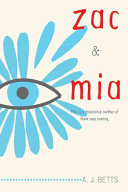2018 School Spending Survey Report
Zac & Mia
304p. ebook available. Houghton Harcourt. Sept. 2014. Tr $17.99. ISBN 9780544331648.
COPY ISBN
 Gr 9 Up—Seventeen-year-old Zac is recovering from a bone marrow transplant when a loud new patient moves into the room next door. While Zac thinks he knows all there is to know about cancer—how to navigate the physical responses to his leukemia treatments and discuss every detail of his bodily functions and fluids without hesitation—Mia's arrival proves that he does not know everything. The two develop a friendship and learn to see beyond their own sickness and circumstances. Told from each teen's perspective over several months, this story is both heartbreaking and hopeful. Zac and Mia are strong and multifaceted protagonists. While Zac comes across as flippant and condescending at first, the development of his positive energy and affections for Mia make him more endearing as the story progresses. Mia's angst and aggression are painfully understandable as she learns to accept the realities of life after cancer and an amputation. Secondary characters add heart to the narrative, and the plot unfolds steadily, which is satisfying without feeling calculated. While comparisons to John Green's The Fault in Our Stars (Dutton, 2012) are inevitable, Zac & Mia holds its own as a smart, well-crafted story about the importance of friendship and feeling understood.—Whitney LeBlanc, Staten Island Academy, NY
Gr 9 Up—Seventeen-year-old Zac is recovering from a bone marrow transplant when a loud new patient moves into the room next door. While Zac thinks he knows all there is to know about cancer—how to navigate the physical responses to his leukemia treatments and discuss every detail of his bodily functions and fluids without hesitation—Mia's arrival proves that he does not know everything. The two develop a friendship and learn to see beyond their own sickness and circumstances. Told from each teen's perspective over several months, this story is both heartbreaking and hopeful. Zac and Mia are strong and multifaceted protagonists. While Zac comes across as flippant and condescending at first, the development of his positive energy and affections for Mia make him more endearing as the story progresses. Mia's angst and aggression are painfully understandable as she learns to accept the realities of life after cancer and an amputation. Secondary characters add heart to the narrative, and the plot unfolds steadily, which is satisfying without feeling calculated. While comparisons to John Green's The Fault in Our Stars (Dutton, 2012) are inevitable, Zac & Mia holds its own as a smart, well-crafted story about the importance of friendship and feeling understood.—Whitney LeBlanc, Staten Island Academy, NYZac, who has leukemia, knows that Mia's got good odds with her diagnosis of osteosarcoma. But Mia, whose leg was amputated, feels anything but lucky. Desperate, she escapes to Zac's family's olive-oil farmcumpetting zoo. Like a certain book by John Green, this Australian import is about teens with cancer in love, but introduces two characters remarkable in their own right.
Let's get this out of the way: yes, like a certain book by John Green, this is a novel about two teens with cancer who fall in love. Don't dismiss it as a copycat, though; this Australian import, told from alternating perspectives, introduces two characters who are remarkable in their own right. Seventeen-year-old Zac, who has leukemia, is stuck in the hospital following a bone-marrow transplant. He's obsessed with statistics, especially about cancer and death, so when Mia arrives next door with a diagnosis of osteosarcoma, Zac knows that she's got good odds. "Ur the luckiest on the ward," he tells her during one of their late-night Facebook chats. But once they're released, Mia feels anything but lucky; during surgery, her leg was amputated below the knee. Desperate and alone, she escapes to Zac's family's (delightfully Aussie) olive-oil farm-cum-petting zoo. The setbacks and heartbreak continue -- such as when the pair attends the funeral of a friend from the hospital -- but Zac's loneliness and Mia's bitterness fade as they discover that, despite their illnesses, they are lucky. "What are the odds of this?" Zac wonders, with Mia curled up next to him. "Shared breath, soft flesh, and the staggering possibility that life can be good again." It's these glimmers of hope -- against an incredibly dark background -- that give the novel a deserving place on the increasingly crowded "kids with cancer" shelf. rachel l. smith
RELATED
ALREADY A SUBSCRIBER? LOG IN
We are currently offering this content for free. Sign up now to activate your personal profile, where you can save articles for future viewing





Be the first reader to comment.
Comment Policy:
Comment should not be empty !!!